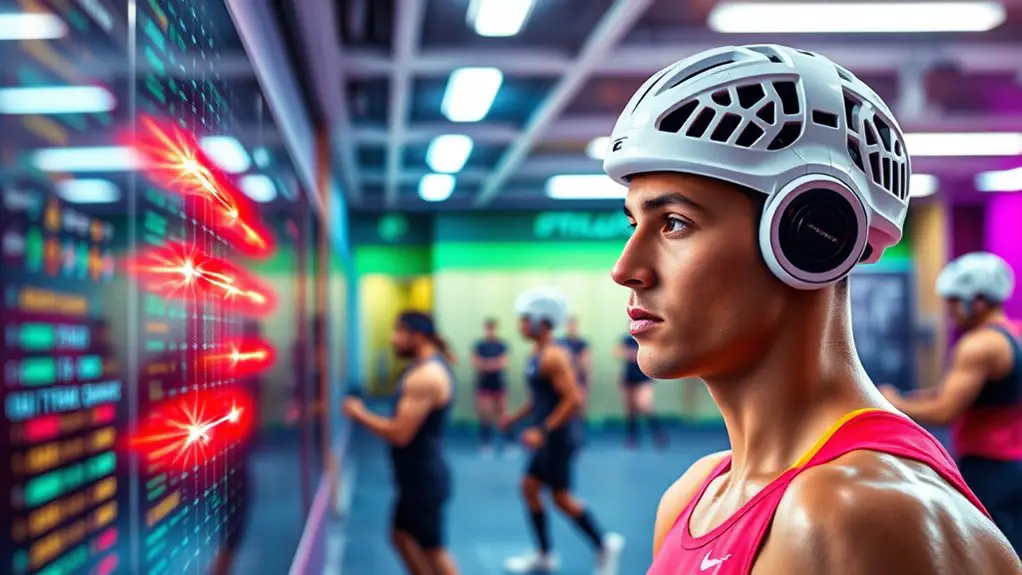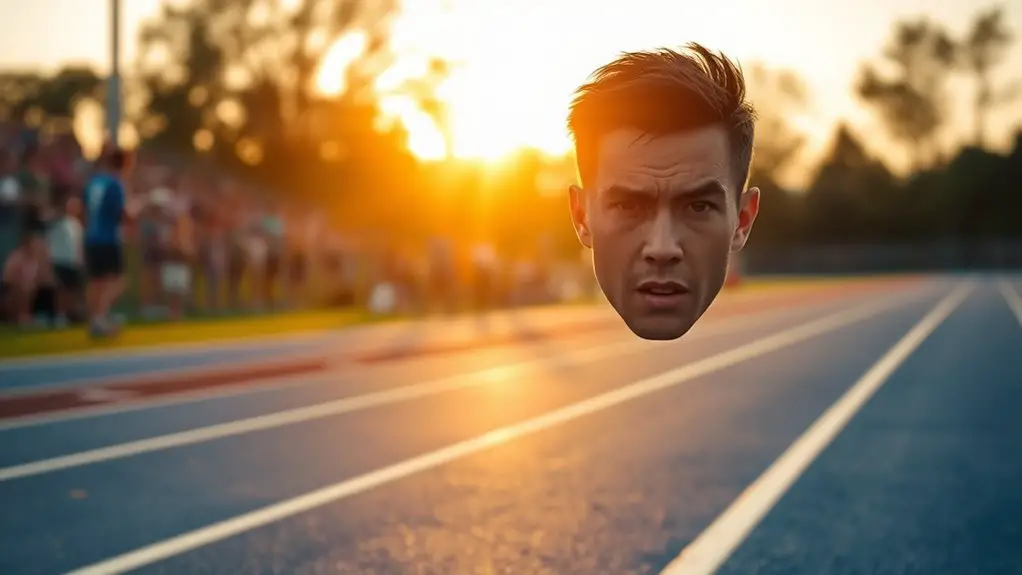Neuroscience plays an essential role in athletic reaction training by optimizing brain function and enhancing neural pathways. This allows you to respond faster, improve decision-making, and strengthen your motor skills. Through cognitive training and neuroplasticity, you can develop mental agility and adaptability, which are vital during competitions. Techniques like mindfulness and visualizations further boost your performance. If you're curious about how these concepts can be integrated into your training, there's much more to explore.
Understanding the Brain's Role in Athletic Performance
When you think about athletic performance, it's easy to focus on physical strength and endurance, but the brain plays an essential role too. Your brain function directly influences how you optimize performance. Strong neural pathways enhance your motor skills, enabling quicker and more precise movements. Athletic psychology highlights the importance of mental resilience and cognitive flexibility, allowing you to adapt to changing circumstances during competition. Moreover, sensory processing helps you interpret information swiftly, which is important for effective decision making on the field. Balancing these mental aspects with physical training creates a powerful synergy that drives your overall performance. So, embrace the freedom to explore both the mind and body in your training regimen. By nurturing your brain's capabilities, you'll not only improve your athletic performance but also enjoy the journey of becoming a more well-rounded competitor. Additionally, developing mental toughness can significantly enhance your ability to perform under pressure and recover from setbacks.
The Science Behind Reaction Time
Although reaction time may seem like a simple concept, it's a complex interplay of neural processes that can greatly impact your athletic performance. Understanding the science behind it can free you to reach new heights. Various reaction time factors influence how quickly you respond, including:
- Neural Pathways: Efficient pathways speed up communication between your brain and body.
- Practice: Repeated exposure sharpens your instincts, allowing for faster responses.
- Fatigue: Physical and mental exhaustion can slow your reactions, hindering your performance.
- Focus: A clear, undistracted mind enhances your ability to react swiftly. Additionally, engaging in agility drills can significantly improve your overall reflexes and response times.
Cognitive Training: Enhancing Mental Agility
Cognitive training can greatly boost your mental agility, allowing you to react faster and more effectively during competition. By enhancing your cognitive flexibility, you'll be better prepared to adapt to unexpected situations. This means you can switch gears quickly, adjusting your strategies based on what's unfolding in front of you.
Incorporating drills that target decision making can sharpen your ability to assess situations and make split-second choices. Whether you're on the field, court, or track, being mentally agile can give you that edge you need to outpace your opponents. Additionally, engaging in visualization techniques can help mentally rehearse scenarios, further enhancing your instinctive reactions.
Think of cognitive training as a way to liberate your mind, freeing it from rigid patterns and opening it up to new possibilities. You'll not only improve your athletic performance but also enjoy the thrill of being fully present and ready to seize opportunities as they arise. Embrace this freedom, and watch your competitive edge soar.
Neuroplasticity and Skill Development
Neuroplasticity, the brain's remarkable ability to reorganize itself by forming new neural connections, plays an essential role in skill development for athletes. By harnessing neuroplasticity benefits, you can enhance your performance and achieve greater skill retention. This means that every time you practice, you're not just repeating movements; you're actively reshaping your brain to respond more effectively. Additionally, incorporating mindfulness in athletic performance can further support the brain's adaptability and enhance your focus during training sessions.
Here are some emotional highlights of embracing neuroplasticity in your training:
- Feel the thrill of mastering new skills faster than ever.
- Experience the joy of watching your hard work translate into improved performance.
- Discover the freedom that comes with enhanced adaptability on the field.
- Embrace the satisfaction of knowing your brain is a powerful ally in your athletic journey.
The Impact of Stress on Reaction Times
When you're under stress, your body releases hormones that can greatly affect your performance. It's essential to understand how these stress hormones impact your reaction times and mental focus during high-pressure situations. By recognizing these effects, you can better prepare yourself to maintain peak performance when it matters most. Additionally, employing breathing techniques can help mitigate the negative effects of stress on your reaction times and enhance your overall focus.
Stress Hormones and Performance
Although stress is often viewed as a hindrance, it can greatly impact your athletic performance, particularly in relation to reaction times. When you experience a stress response, hormone regulation kicks in, releasing adrenaline and cortisol. These hormones can sharpen your focus, but they can also cloud your judgment if you don't manage them well.
Consider how stress can:
- Heighten your alertness, making you react faster.
- Distract you, causing missed opportunities.
- Influence your body's ability to recover.
- Shift your energy levels, for better or worse.
Understanding this duality can empower you to harness stress effectively, allowing you to break free from its chains and elevate your performance. Embrace the challenge, and turn stress into an ally.
Mental Focus Under Pressure
As stress mounts during high-pressure situations, maintaining mental focus becomes essential for athletes aiming to optimize their reaction times. You know that mental resilience is key; it helps you push through distractions and stay in the moment. When pressure cranks up, your brain can easily get overwhelmed, leading to slower reactions. That's where pressure management techniques come into play. Whether it's visualization, breathing exercises, or mindfulness, these tools help you regain control. By training your mind to stay calm, you'll improve your ability to react quickly and effectively. Remember, it's not just about physical training; your mental game plays a huge role in performance. Embrace these strategies and watch your reaction times transform under pressure.
Visualization Techniques for Better Performance
Visualization techniques can markedly enhance your athletic performance by harnessing the power of mental imagery. By practicing mental imagery exercises, you can train your brain to react more quickly and effectively under pressure. Implementing brain training strategies alongside physical training can lead to impressive improvements in your overall reaction times. Additionally, meditation enhances mental conditioning by cultivating heightened awareness, which further supports your ability to visualize and execute actions during competition.
Mental Imagery Exercises
When you engage in mental imagery exercises, you're tapping into a powerful tool that can enhance your athletic performance. These imagery techniques allow you to visualize success, leading to increased confidence and focus. Here are some visualization benefits you can experience:
- Enhanced Performance: Picture yourself achieving your goals in vivid detail.
- Increased Motivation: Imagine the freedom of reaching new heights in your sport.
- Reduced Anxiety: Visualizing calm and control can ease pre-competition nerves.
- Improved Focus: Envisioning specific skills helps sharpen your concentration.
Brain Training Strategies
Mental imagery exercises set the stage for a broader range of brain training strategies that can elevate your performance. By incorporating visualization techniques, you're not just dreaming about success; you're actively shaping your brain fitness. Picture yourself in high-pressure situations, executing flawless moves. This mental rehearsal strengthens cognitive resilience, allowing you to bounce back from setbacks with ease.
You can also experiment with mindfulness meditation, which enhances focus and clarity, or engage in puzzles and strategy games to sharpen your decision-making skills. Remember, the more you nourish your brain, the better equipped you'll be to tackle challenges. Embrace these brain training strategies, and you'll gain the freedom to perform at your best, both mentally and physically.
The Use of Technology in Reaction Training
As athletes seek to enhance their performance, technology plays an essential role in reaction training. Embracing these advancements can open a new level of freedom in your training regimen. Consider how the following tools can elevate your game:
- Virtual Reality – Immerse yourself in realistic simulations that challenge your instincts.
- Wearable Devices – Monitor your performance in real-time, using data analytics to optimize your training.
- Cognitive Apps – Sharpen your mental agility with gamified training and interactive platforms designed for athletes.
- Feedback Systems – Receive immediate insights on your performance, allowing for quick adjustments and growth.
Utilizing these technologies, like brain-computer interfaces and mobile applications, not only enhances your reaction time but also empowers you to push beyond your limits. Furthermore, integrating AI-enhanced performance analytics into your training can provide deeper insights into your strengths and weaknesses, enabling you to make more informed decisions. Embrace the freedom to explore new techniques and redefine your athletic potential.
Case Studies: Neuroscience in Action
While many athletes understand the importance of reaction time, the application of neuroscience in actual training can be truly transformative. In recent case studies, athletes have successfully harnessed brain mapping techniques to enhance their athletic cognition. For instance, a soccer player underwent a program that utilized real-time brain imaging to identify cognitive bottlenecks affecting reaction speed. By addressing these areas through targeted drills, they improved their decision-making and response time on the field.
Another example involves a sprinter who leveraged neuroscience to develop mental strategies that fine-tuned their reaction to starting signals. This athlete's brain mapping revealed specific neural pathways that could be strengthened for faster responses. These real-world applications illustrate how neuroscience can reshape training routines, empowering you to break free from traditional methods and elevate your game. By tapping into your brain's potential, you can unleash new levels of performance and agility. Additionally, integrating biofeedback techniques in training can enhance the connection between mental state and physical performance.
Integrating Neuroscience Into Training Regimens
Integrating neuroscience into training regimens can markedly enhance an athlete's performance, especially when tailored to individual needs. By utilizing techniques like neurofeedback training, you can access your brain's potential and elevate your skills. Here's how you can experience this transformation:
Integrating neuroscience into your training can unlock your full potential and elevate your athletic performance.
- Boost your cognitive flexibility – Adapt to changing conditions with ease.
- Sharpen your reaction time – Respond to opponents and situations faster.
- Enhance focus and concentration – Maintain clarity even under pressure.
- Cultivate emotional resilience – Stay composed and confident during high-stakes moments.
These elements not only improve your athletic abilities but also grant you the freedom to express yourself fully in your sport. Embracing neuroscience enables you to break through barriers, discover new heights, and ultimately enjoy the journey of athleticism. Additionally, incorporating visualization techniques into your training can further enhance your mental performance and confidence. So, why not take that leap and integrate these powerful techniques into your training? Your future self will thank you.
Future Trends in Athletic Training and Neuroscience
As you consider the future of athletic training, think about how neuroplasticity can enhance an athlete's performance. With advancements in technology, integrating personalized training approaches will become more accessible and effective. You'll want to stay ahead of these trends to optimize your training methods and outcomes.
Neuroplasticity in Athletes
Neuroplasticity, the brain's ability to reorganize itself by forming new neural connections, plays an essential role in athletic training, especially as athletes seek to enhance their performance. Embracing neuroplasticity benefits can lead to remarkable transformations in your game. Consider the power of adaptive learning, which allows you to:
- Master new skills faster than ever.
- Recover from setbacks with greater resilience.
- Improve decision-making under pressure.
- Enhance coordination and agility in your movements.
These elements not only elevate your performance but also empower you to break free from limitations. By harnessing the potential of your brain's adaptability, you can open up your true athletic potential and experience the freedom to push boundaries like never before.
Technology Integration Advancements
Harnessing neuroplasticity isn't just about mental adaptation; it's also about leveraging cutting-edge technology to enhance athletic training. Imagine using virtual reality to immerse yourself in reaction simulations that mimic real-game situations. With wearable technology, you can track your performance analytics in real-time, gaining insights through data visualization. Cognitive assessments can pinpoint your strengths and weaknesses, allowing for targeted improvement. Training apps create engaging feedback loops, helping you stay motivated while refining your skills. Brain-computer interfaces could take this a step further, connecting your mind directly to your training regimen. These advancements create immersive environments where you can truly explore your potential, leading to a more liberated approach to training that maximizes both mind and body.
Personalized Training Approaches
With advancements in neuroscience reshaping the landscape of athletic training, personalized approaches are becoming the norm rather than the exception. Imagine training that truly understands you and your needs. Here's how personalized training can transform your experience:
- Customized drills designed to match your unique skills and challenges.
- Adaptive feedback that evolves as you improve, keeping you engaged and motivated.
- A training atmosphere where your individuality is celebrated, not standardized.
- The freedom to explore your potential without the constraints of one-size-fits-all methods.
Embracing these personalized strategies can reveal your true athletic prowess, making each session more fulfilling and aligned with your goals. You deserve a training experience that's as unique as you are!
Frequently Asked Questions
How Does Nutrition Affect Brain Function in Athletes?
Nutrition plays an essential role in your brain function, especially as an athlete. When you fuel your body with the right nutrients, you're supporting cognitive enhancement and overall brain health. Foods rich in omega-3s, antioxidants, and vitamins can boost your focus and reaction times. This means you're not just training your body but also sharpening your mind. So, if you want to enhance your performance, don't underestimate the power of good nutrition!
Can Age Impact Reaction Time in Sports?
Absolutely, age can impact your reaction time in sports. As you get older, you might notice an age-related decline in not just speed but also cognitive flexibility. This means that processing information and adapting to new situations can take a bit longer. While you can still stay competitive, it's crucial to address these changes with tailored training and strategies that keep you sharp, ensuring you can enjoy your sport for years to come.
What Role Does Sleep Play in Athletic Performance?
Imagine you're a sprinter preparing for a big race. You've trained hard, but if you don't get quality sleep, your performance might suffer. Sleep deprivation can slow your reaction time, impair decision-making, and reduce endurance. Studies show that athletes who prioritize sleep often outperform those who don't. So, if you wanna maximize your potential, focus on improving your sleep quality. It's not just about training; it's about resting right too!
Are There Specific Exercises to Improve Brain Function?
If you're looking to boost your brain function, there are plenty of brain exercises and cognitive training activities you can try. Puzzles, memory games, and even learning a new skill can sharpen your mind. Regularly engaging in these activities keeps your brain agile and enhances your ability to process information. So, embrace the freedom to explore various exercises that not only challenge you but also make your brain work better.
How Do Emotions Influence Athletic Performance and Reaction Time?
Emotions can be like a double-edged sword in athletics, slicing through focus and clarity. When you master emotion regulation, you're able to dance gracefully with stress management, turning pressure into performance. If anxiety grips you, your reaction time may falter, but channeling that energy can ignite your instincts. By keeping your emotions in check, you're not just surviving the game; you're thriving, releasing the freedom to respond with lightning speed when it counts.



